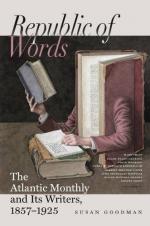the sacred carpenter, had appeared in a vision, and
revealed to him certain secrets of coloring.
Mrs. Blake delighted to assist him in taking impressions,
which she did with great skill, in tinting the designs,
and in doing up the pages in boards; so that everything,
except manufacturing the paper, was done by the poet
and his wife. Never before, as his biographer
justly remarks, was a man so literally the author of
his own book. If we may credit the testimony
that is given, or even judge from such proofs as Mr.
Gilchrist’s book can furnish, these works of
his hands were exquisitely beautiful. The effect
of the poems imbedded in their designs is, we are
told, quite different from their effect set naked upon
a blank page. It was as if he had transferred
scenery and characters from that spirit-realm where
his own mind wandered at will; and from wondrous lips
wondrous words came fitly, and with surpassing power.
Confirmation of this we find in the few plates of
“Songs of Innocence” which have been recovered.
Shorn of the radiant rainbow hues, the golden sheen,
with which the artist, angel-taught, glorified his
pictures, they still body for us the beauty of his
“Happy Valley.” Children revel there
in unchecked play. Springing vines, in wild exuberance
of life, twine around the verse, thrusting their slender
coils in among the lines. Weeping willows dip
their branches into translucent pools. Heavy-laden
trees droop their ripe, rich clusters overhead.
Under the shade of broad-spreading oaks little children
climb on the tiger’s yielding back and stroke
the lion’s tawny mane in a true Millennium.
The first series, “Songs of Innocence,”
was succeeded by “Songs of Experience,”
subsequently bound in one volume. Then came the
book of “Thel,” an allegory, wherein Thel,
beautiful daughter of the Seraphim, laments the shortness
of her life down by the River of Adona, and is answered
by the Lily of the Valley, the Little Cloud, the Lowly
Worm, and the Clod of Clay; the burden of whose song
is—
“But how this is, sweet maid, I
know not, and I cannot know,
I ponder, and I cannot ponder: yet
I live and love!”
The designs give the beautiful daughter listening
to the Lily and the Cloud. The Clod is an infant
wrapped in a lily-leaf. The effect of the whole
poem and design together is as of an “angel’s
reverie.”
The “Marriage of Heaven and Hell” is considered
one of the most curious and original of his works.
After an opening “Argument” comes a series
of “Proverbs of Hell,” which, however,
answer very well for earth: as, “A fool
sees not the same tree that a wise man sees”;
“He whose face gives no light shall never become
a star”; “The apple-tree never asks the
beech how he shall grow, nor the lion the horse how
he shall take his prey.” The remainder
of the book consists of “Memorable Fancies,”
half dream, half allegory, sublime and grotesque inextricably
commingling, but all ornamented with designs most




